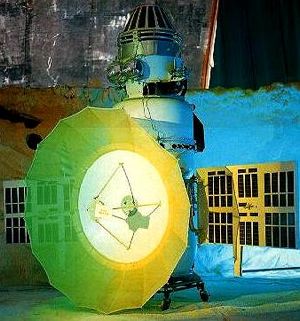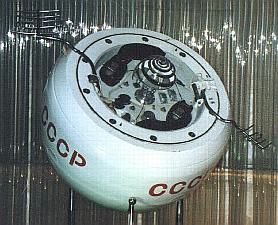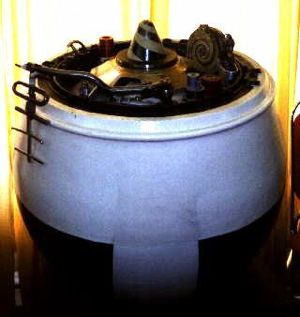
Home - Search - Browse - Alphabetic Index: 0- 1- 2- 3- 4- 5- 6- 7- 8- 9
A- B- C- D- E- F- G- H- I- J- K- L- M- N- O- P- Q- R- S- T- U- V- W- X- Y- Z
Venera 3V (V-72)
Part of 3MV Family

Venera 8
Venera 3V (V-72). Others in the 3V / 3MV series had a similar appearance.
Credit: NASA |
Russian Venus probe. Venus atmospheric probe; instrumentation included temperature, pressure, and light sensors as well as radio transmitters. Venus lander, Russia. Launched 1972.
AKA: 3V (V-72). Status: Operational 1972. First Launch: 1972-03-27. Last Launch: 1972-03-31. Number: 2 . Gross mass: 1,180 kg (2,600 lb).
Velocity at Venus was reduced from 41,696 km/hr to about 900 km/hr by aerobraking. The 2.5 meter diameter parachute opened at an altitude of 60 km, and a refrigeration system was used to cool the interior components. Transmitted data during the descent and continued to send back data after landing.
More at: Venera 3V (V-72).
Family: Venus.
Country: Russia.
Engines: KDU-414.
Launch Vehicles: R-7,
Molniya 8K78M.
Projects: Venera.
Launch Sites: Baikonur,
Baikonur LC31.
Agency: MOM,
Lavochkin bureau.
Bibliography: 2,
296,
6,
64,
65,
13336.
Photo Gallery
 | Venera 8 Lander
Credit: NASA |
 | Venera 8 lander
Venera-8/9 landing capsule
Credit: Andy Salmon |
 | Venera 8
Credit: Manufacturer Image |
1972 March 27 - .
04:15 GMT - .
Launch Site: Baikonur.
Launch Complex: Baikonur LC31.
LV Family: R-7.
Launch Vehicle: Molniya 8K78M.
- Venera 8 - .
Payload: 3V (V-72) s/n 670. Mass: 1,180 kg (2,600 lb). Nation: Russia.
Agency: MOM.
Program: Venera.
Class: Venus.
Type: Venus probe. Spacecraft Bus: 3MV.
Spacecraft: Venera 3V (V-72).
Decay Date: 1972-07-22 . USAF Sat Cat: 5912 . COSPAR: 1972-021A. Apogee: 246 km (152 mi). Perigee: 194 km (120 mi). Inclination: 51.7000 deg. Period: 88.90 min.
Venus atmospheric probe. The spacecraft took 117 days to reach Venus, entering the atmosphere on 22 July 1972. Descent speed was reduced from 41,696 km/hr to about 900 km/hr by aerobraking. The 2.5 meter diameter parachute opened at an altitude of 60 km, and a refrigeration system was used to cool the interior components. Venera 8 transmitted data during the descent and continued to send back data for 50 minutes after landing. The probe confirmed the earlier data on the high Venus surface temperature and pressure returned by Venera 7, and also measured the light level as being suitable for surface photography, finding it to be similar to the amount of light on Earth on an overcast day.
1972 March 31 - .
04:02 GMT - .
Launch Site: Baikonur.
Launch Complex: Baikonur LC31.
LV Family: R-7.
Launch Vehicle: Molniya 8K78M.
FAILURE: The escape stage Block L's engine cut off 125 seconds after ignition due to timer failure.. Failed Stage: U. - Cosmos 482 - .
Payload: 3V (V-72) s/n 671. Mass: 1,180 kg (2,600 lb). Nation: Russia.
Agency: MOM.
Program: Venera.
Class: Venus.
Type: Venus probe. Spacecraft Bus: 3MV.
Spacecraft: Venera 3V (V-72).
Decay Date: 1981-05-05 . USAF Sat Cat: 5919 . COSPAR: 1972-023A. Apogee: 9,806 km (6,093 mi). Perigee: 204 km (126 mi). Inclination: 52.0000 deg. Period: 201.40 min.
Home - Search - Browse - Alphabetic Index: 0- 1- 2- 3- 4- 5- 6- 7- 8- 9
A- B- C- D- E- F- G- H- I- J- K- L- M- N- O- P- Q- R- S- T- U- V- W- X- Y- Z
© 1997-2017 Mark Wade - Contact
© / Conditions for Use
|




